Well, so much for my New Year’s resolution of getting a Vintage Tastings update out each week! Truth be told, I was getting it ready for the weekend edition of the Acker Weekly, but then I was told there was none last week. Oops. So now I will finish something each weekend to be on the safe side, starting with a special, recent evening at Marea, one of my favorite restaurants in the world.
There once was a King, who gave up his crown, for a much higher purpose, but the wine still went down. There is only one way that wine can go down in my book – the hatch – and the first of the year always means one thing – it is time to coronate The Cardinal in a birthday celebration fit for a former King. In the interest of getting out one Vintage Tastings update every week, this article will focus its individual notes on the Champagnes opened on 2013’s first official celebration. Since Big Boy took this New Year’s off, it is only right that the Church stepped in and covered accordingly.
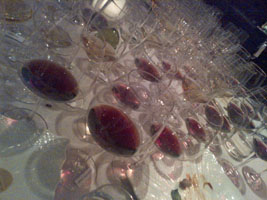
Cardinal Excess
The 1964 Krug had divine aromas of vanilla, sugar, bread and yeast. Its palate was smooth and buttery, possessing just a light amount of fizz. It was delicious and long, broad and dusty with a touch of orange rind on its finish and more vanilla flavors (95).
There was a 1964 Moet magnum next, disgorged in 1995, as Bad Boy was quick to point out. Bad Boy and The Cardinal have always been a bit of an unholy alliance, as Bad Boy has never been one to seek forgiveness, and he didn’t have to thanks to the Moet. It was fresh with great butter and white sugar aromas. Wheat, grain, zip and length all made its nose delightfully complex, along with grilled nuts. The palate unfortunately was not as good, as it was quite dirty despite being zippy and vivacious (91M).
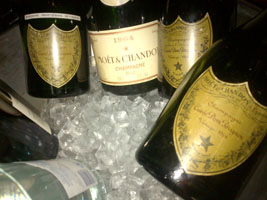
Four of A Kind
A trio of Doms from the ’60s were next, beginning with the 1966 Dom Perignon. Its nose was heavenly. It smelled like buttered sex with light toast, both in perfect harmony with its sunny, yellow fruit. The palate was excellent; yummy and long with more yellow fruits, although it felt a touch dry. It had a wheaty finish and dried out sooner than later, a function of the bottle more than the wine. Old Champagne is more volatile than any other category, it’s that any given Sunday thing (94).
The 1964 Dom Perignon had a much more mature color and nose but was still fresh. There was ‘an element of richness in the Dom not in the Moet.’ The palate was tasty and earthy with benevolent salt, soup and seawater flavors. There was more fruit here, and a nice kink of ginger ale developed as it opened (95).
The 1962 Dom Perignon had much more austerity in its nose; glue dominated, but its palate had the best sweetness of the trio. Wafer emerged all over the nose, in a cracker rather than cookie style. The palate was delicious and better than the ’64’s, a bit more open and giving, as this vintage is prone to do. 1962 is probably the most overlooked vintage of the decade, which many feel is still Champagne’s greatest of all-time (95+).
A 1973 Dom Perignon Oenotheque bottling was one disgorged in 1999. The Cardinal and his crew are always quick to point out disgorgement dates. I strongly feel that recently disgorged Champagnes need about ten years in the bottle to show their mature qualities again, so this bottle qualified accordingly. There was a bit of truffle oil in the nose, which had a baked quality in a positive way. The palate was still fresh and zippy, with flavors of hay and wet straw. There was a lot of power and length in this very dry Champagne (94).
The next Champagne was a rare 1979 Philipponat Clos des Goisses. Its nose was big and wheaty, tangy, bready and zippy. Flavors of wheat and yeast were complemented by a robust finish full of exotic tea flavors. This showed more of the natural wisdom that comes with age (94).
The last Champagne on this night was an excellent but advanced 1973 Roederer Cristal. Bad Boy offered an interesting theory on why more old Cristals tended to be advanced than any other fine Champagne – the clear glass. If they used a dark green glass like Dom Perignon and Krug etc, it would prevent more premature aging. That made a lot of sense. The Cristal’s nose was mature and toasty, and its palate was full of tasty caramel flavors. It was still zippy and got better in the glass, coming across in a lush manner with a vibrating finish. It was too bad that this bottle wasn’t perfect, but I definitely enjoyed it (94A).
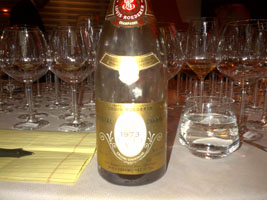
Clear Glass Syndrome
| 1. | 1934 Montrose | (92) |
| 2. | 1934 La Mission Haut Brion | (94) |
| 3. | 1934 Trotanoy | (93) |
| 4. | 1964 Leroy Echezeaux | (89) |
| 5. | 1964 Leroy Grands Echezeaux | (93) |
| 6. | 1964 Clos de Tart | (92A) |
| 7. | 1966 DRC La Tache | (94) |
| 8. | 1991 DRC Echezeaux | (93) |
| 9. | 1991 DRC Grands Echezeaux | (94) |
| 10. | 1990 DRC Grands Echezeaux | (94+) |
| 11. | 1988 DRC Grands Echezeaux | (93) |
| 12. | 1990 Dujac Bonnes Mares | (95) |
The flight of 34s was a fascinating one. The noses and aromas in these timeless classics were magnificent, but the palates did not live up to the noses, delivering a weaker, kinder and gentler experience that one might expect at this age, from a vintage that was very good but not great. The Montrose had the least dimension, while the La Mission kept getting better, actually gaining some strength and showing signature qualities such as chocolate, wafer, cedar, gravel and mesquite. The Trotanoy was just delicious, the ‘best’ of flight per The Cardinale, and it showed the most (purple) fruit on the palate, along with honey, herbs, cassis, tomato and beef bouillon cube. It was initially my favorite as well, but it got lighter in the glass relatively quickly while the La Mission improved.
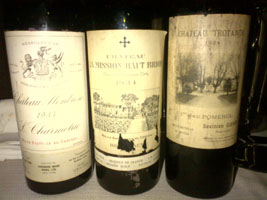
It Was A Very Good Year
The mature Burg flight was less interesting to me, as the Leroy Echezeaux was simple, and the Clos de Tart was advanced and leaning on the tutti-frutti side. The Grands Echezeaux had a great nose, but the palate was round with rubber on its sturdy finish. It was a bit brawnier than I would have liked. The La Tache, of course, was the best of flight, as it should have been. I have always found ’66 to be a bit of a dirty vintage for La Tache, and this was no exception. There was still excellent acid here and classic qualities of rose, vitamins, horseradish, tomato and crushed citrus juice m’©lange, but I will never find this vintage of La Tache to be an outstanding one.
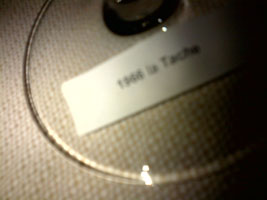
In A Class By Itself
The young Burg flight was solid, with the three DRC Grands Echezeaux’s battling it out for supremacy. The CEO found the 1991 better than the 1990, and it was more exotic and open than the powerful 1990. The 1991 had a nose with great spice and a mix of cedar, bamboo and mahogany, along with some frogs and mushrooms in that forest. Blood and rose oil concentrate rounded out its nose, while its palate was round and long, with excellent spice and acid. The 1990 was more bloody, with more steak, rubber and rose, a bit of a flytrap of a wine. It lurked a bit, waiting for a future time to pounce. The Echezeaux, by the way, had a great nose, but the palate lagged a step. It had an unusual pinch of Jaegermeister in its nose. The 1988 was big and full of acid, citrusy and cedary, lacking the fruit of the other vintages but still excellent. What stole the show this night was a surprise bottle courtesy of Bad Boy, a 1990 Dujac Bonnes Mares. While I didn’t take many notes at this point, I did clearly write down how I thought it was the wine of the night. It had an elegance to it that the DRC’s didn’t, while still possessing meaty complexity to its fruit. It danced, dodged, zipped and zagged. It was a case of good timing, as the Domaine’s first ever consignment direct from their cellars is coming up this weekend, including legendary wines from all their greatest vintages and rare, large formats.

Red – White So Happy Together
HEADS UP!!!
In Vino Veritas,
JK
